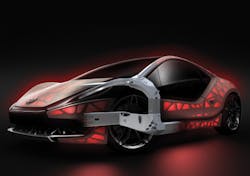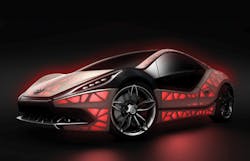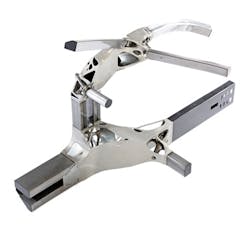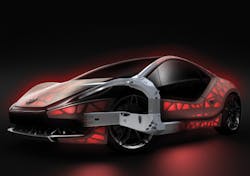WIESBADEN, GERMANY - EDAG Engineering's concept sports car, dubbed "Light Cocoon," has a bionically designed and additively manufactured vehicle structure, covered with an outer skin made from weatherproof textile material (FIGURE 1). In a joint project, EDAG Engineering, Laser Zentrum Nord (Hamburg, Germany), Concept Laser (Lichtenfels, Germany), and the BLM Group (Cantù, Italy) created the bionically optimized spaceframe produced by hybrid manufacturing to highlight a new way in which a bodywork concept that is adaptable and can be manufactured flexibly. Additively manufactured bodywork nodes and intelligently processed profiles are combined. Thanks to additive manufacturing, the nodes can be configured to be highly flexible and multifunctional so that, for example, different versions of a vehicle can be produced "on demand" without any additional tooling, equipment, and start-up costs. Steel profiles are used as connecting elements—they, too, can easily be adapted on an individual basis to the specified load levels by providing them with different wall thicknesses and geometries.
The NextGen spaceframe is a combination of additively manufactured 3D nodes and intelligently processed steel profiles (FIGURE 2). The nodes can be manufactured onsite for the particular version known as "just in sequence" (JIS), along with the profiles, which are cut to the appropriate shape and length initially using 3D bending and then by employing 2D and 3D laser cutting processes. The focus is on joining together individual components to create a hybrid structure to produce topologically optimized structures that are not yet possible at present. The components are welded together with a fillet weld on the lap joint. The geometric basis for this is the complete shoeing of the profiles all the way round, and this is also produced on demand via additive manufacturing through 3D measuring of the profiles (FIGURE 3). This joint enables circumferential welding to produce a connection over a long length along with excellent prepositioning of the components.
The profiles are automatically aligned and fixed in place by the node, and a high-brightness laser with robot-guided optics is used. In addition, the laser techniques used to produce profiles and nodes can largely be automated in assembly. The additively manufactured nodes can be adapted to reflect each load stage, which means that each version is designed for the optimum weight and function. The hybrid design spans the required distances of the structure with the profiles, while the nodes are used to connect the profiles together. EDAG Engineering was responsible for devising and optimizing the spaceframe concept, Laser Zentrum Nord did the laser welding, the BLM Group undertook the 3D bending and laser cutting, and Concept Laser performed the additive manufacturing of the nodes.
The spaceframe concept combines the advantages of 3D printing, such as flexibility and the potential for lightweight construction, with the efficiency of proven conventional profile designs. The laser plays the key role in both technologies. The topologically optimized nodes enable the maximum lightweight construction that is possible at the present time, and a high degree of functional integration. The result is a spaceframe structure with an optimized load path. By employing processes that do not involve much use of apparatus or tools, it will be possible in the future to manufacture all bodywork versions economically and with the greatest possible flexibility.
For more information, please visit www.edag.de.



